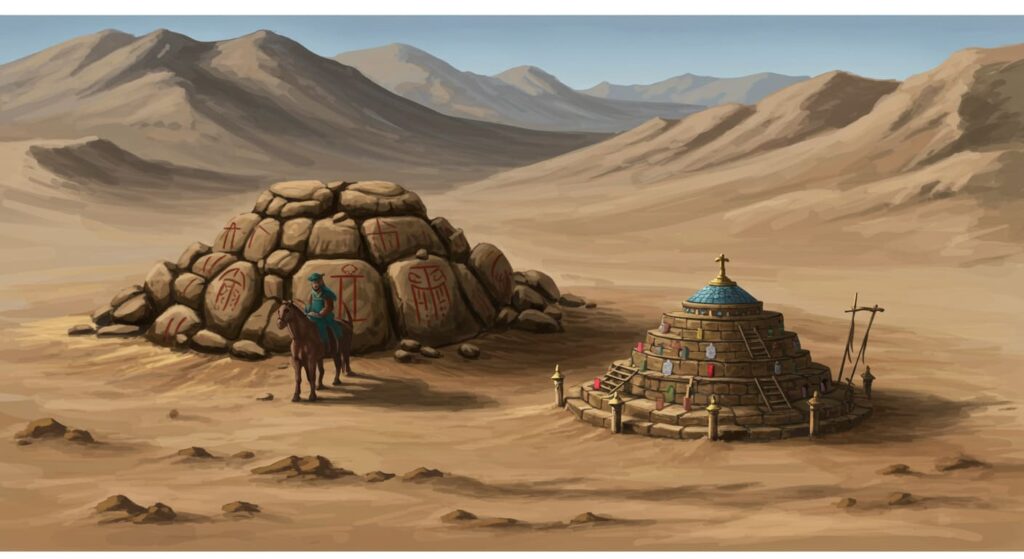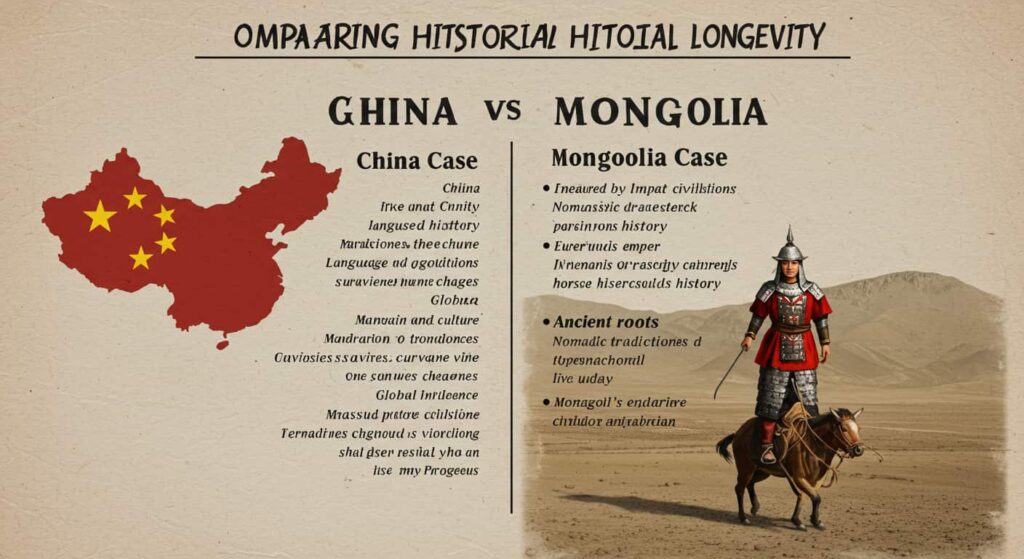The question “who has a longer history, China or Mongolia” is one that sparks curiosity among history lovers, researchers, and even travelers. Both nations have left remarkable footprints on the global stage, yet their historical timelines unfold in very different ways.
China is often recognized as the world’s oldest continuous civilization, with written records stretching back thousands of years. Mongolia, on the other hand, may not claim the same type of continuity, but its nomadic heritage, tribal confederations, and the Mongol Empire under Genghis Khan left an impact on global history that is still felt today.
To answer this question fairly, we need to look at origins, dynasties, empires, cultural traditions, and historical influence. Let’s take a deep journey into both civilizations.
Ancient Origins of China
China’s history is not only long but also unusually continuous, which sets it apart from most civilizations.
Prehistoric China
- Homo erectus fossils like Peking Man date back around 700,000 years, showing that humans have lived in China since ancient times.
- Neolithic cultures such as Yangshao (5000–3000 BCE) and Longshan (3000–1900 BCE) developed farming, pottery, weaving, and early settlements.
Early Dynasties
- Xia Dynasty (2100–1600 BCE): Considered the first dynasty, though debated, it marks the beginning of Chinese statehood.
- Shang Dynasty (1600–1046 BCE): Known for oracle bones, early Chinese script, bronze casting, and city-states.
- Zhou Dynasty (1046–256 BCE): Introduced the Mandate of Heaven and gave rise to Confucianism and Taoism.
These foundations laid the path for one of the most enduring civilizations in history.
Ancient Origins of Mongolia
Mongolia’s early history is equally fascinating, though less centralized. The Mongolian plateau was home to nomadic tribes long before the rise of the Mongol Empire.

Prehistoric Mongolia
- Evidence shows humans lived in Mongolia over 40,000 years ago.
- Rock paintings, burial sites, and artifacts reveal a rich nomadic culture.
Early Tribal Confederations
- Xiongnu Confederation (3rd century BCE – 1st century CE): Rivaled early Chinese states and pressured the Han Dynasty.
- Rouran Khaganate (4th–6th centuries): One of the earliest groups to use the title “Khan.”
- Göktürks (6th–8th centuries): Powerful steppe empire that spread Turkic culture.
Though Mongolia didn’t form dynasties like China, its nomadic tribes often influenced or threatened neighboring civilizations.
China’s Long Dynastic Continuity
China’s greatness is often measured in its dynastic cycles:
- Qin Dynasty (221–206 BCE): First unification of China; built early Great Wall sections.
- Han Dynasty (206 BCE–220 CE): Expanded territory, developed the Silk Road, and became a golden age.
- Tang Dynasty (618–907): A peak of poetry, art, and cosmopolitan culture.
- Song Dynasty (960–1279): Innovated in printing, gunpowder, and paper money.
- Ming Dynasty (1368–1644): Known for the Forbidden City, Zheng He’s voyages, and strengthening the Great Wall.
- Qing Dynasty (1644–1912): The last imperial dynasty before modern China.
What stands out is the unbroken thread of governance, culture, and language, making China unique in world history.
Also read: Kim Chestney Radical Intuition PDF Free Download
Mongolia’s Great Leap: The Mongol Empire
While China was building continuity, Mongolia was preparing for a revolutionary rise.
Genghis Khan and the Mongols
- In the early 13th century, Genghis Khan united the Mongol tribes.
- By his death in 1227, the Mongols controlled vast parts of Asia.
- The empire later expanded under his successors, becoming the largest contiguous land empire in history.
Legacy of the Mongol Empire
- Established safe trade routes across Eurasia through the Silk Road.
- Encouraged cultural and technological exchanges between East and West.
- Practiced religious tolerance, allowing Buddhism, Islam, Christianity, and others to coexist.
The Mongol Empire’s influence reached from China to Europe, something few empires could achieve.
Comparing Historical Longevity

When asking “who has a longer history, China or Mongolia,” the answer depends on perspective.
China’s Case
- Continuity: Over 3,500 years of recorded history.
- Language and culture: Mandarin and traditions survived countless dynastic changes.
- Global influence: Inventions like paper, compass, and gunpowder shaped human progress.
Mongolia’s Case
- Ancient roots: Nomadic traditions go back thousands of years.
- Global empire: The Mongols dramatically changed Eurasia’s history.
- Cultural endurance: Nomadism, horsemanship, and steppe traditions remain alive today.
If measured by continuous civilization, China wins. If measured by impact during key periods, Mongolia’s empire rivals any civilization.
Shared Histories: China and Mongolia
The two civilizations were often rivals, but also deeply intertwined.
- The Great Wall of China was built to defend against Mongol and other northern tribes.
- The Yuan Dynasty (1271–1368): Founded by Kublai Khan, represented a period when Mongols ruled China.
- Trade and cultural exchange through the Silk Road connected them for centuries.
This shows that while distinct, the histories of China and Mongolia cannot be separated.
Also read: Sztavrosz
Cultural and Philosophical Contributions
China’s Legacy
- Confucianism, Taoism, and Buddhism shaped ethics, governance, and lifestyle.
- Contributions to art, calligraphy, and literature remain global treasures.
- Inventions like the compass and paper spread worldwide.
Mongolia’s Legacy
- Nomadic resilience and horsemanship defined their culture.
- The Mongol Empire promoted religious tolerance and global exchange.
- Their military strategies influenced warfare for centuries.
Both left lasting marks on world history in different ways.
Modern Perspectives
- China today is a global superpower, carrying its ancient heritage into the modern age.
- Mongolia today embraces its nomadic traditions while balancing modernization.
The comparison between the two is not about superiority, but about appreciating their unique roles in history.
FAQs
1. Who has a longer continuous history, China or Mongolia?
China has a longer continuous history, with written records dating back 3,500 years.
2. When did Mongolia’s history begin?
Mongolia’s history dates back at least 40,000 years, though its recorded history starts with nomadic confederations.
3. What was China’s first dynasty?
The Xia Dynasty (2100 BCE–1600 BCE), though debated, is considered China’s first dynasty.
4. Who was Genghis Khan?
He was the founder of the Mongol Empire, which became the largest contiguous land empire in history.
5. Did Mongolia ever rule China?
Yes, during the Yuan Dynasty (1271–1368), China was ruled by the Mongols under Kublai Khan.
6. What is China’s most important contribution to the world?
Inventions like paper, gunpowder, printing, and the compass had global impact.
7. What is Mongolia’s biggest historical contribution?
The Mongol Empire unified Eurasia, boosting trade, cultural exchange, and diplomacy.
8. Which is older: Chinese or Mongolian civilization?
Chinese civilization is older in continuous written form, though Mongolia’s nomadic traditions are also ancient.
9. How are China and Mongolia connected historically?
They were often rivals, but also connected through trade, warfare, and dynastic rule.
10. Why is it difficult to compare China and Mongolia’s history?
Because China emphasizes continuity, while Mongolia emphasizes expansion and influence—both unique but equally important.
Conclusion:
China has the world’s longest continuous recorded civilization, stretching over 3,500 years with dynasties, philosophies, and inventions that continue to shape humanity.
Mongolia may not have the same continuous timeline, but its global influence, especially through the Mongol Empire, was transformative and far-reaching.
Rather than competing, their histories should be seen as complementary. China represents continuity and endurance, while Mongolia symbolizes transformation and expansion. Both have enriched world history in unique ways.
Related post:














